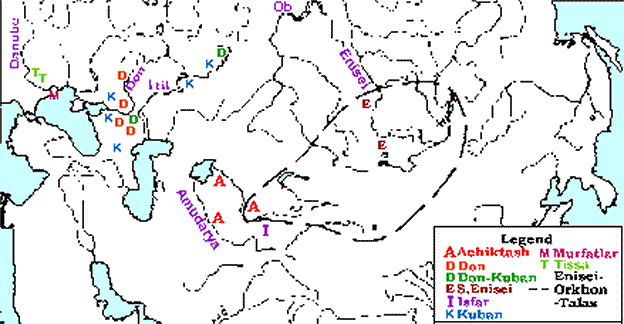Paleography of 8 Türkic Alphabets · Codex of Inscriptions-Euro Asiatic- Don · Codex of Inscriptions-Euro Asiatic- Kuban
European Türkic Grammar
by Soslanbek Baichorov
|
Introduction |
In his book, Ancient Türkic Runic Monuments of Europe, Soslan Baichorov provided the grammatical rules used in the conventional writings. The citation below is taken from the S. Baichorov's book, p. 35.
In parenthesis, to avoid possible misinterpretation, are shown the Cyrillic-derived phonetic symbology used by S. Baichorov.
S. Baichorov laconically summarizes the spelling rules on page 262 of his book. Note the charming simplicity of the rules, which resemble the famous definition of the Singer sawing machine patent "The machine has the hole for the thread located at the end of the needle":
Page 262.
"As can be seen from stated above, the results of the decoding of the European area runic inscriptions agree with the ancient common Turkic spelling rules of the vowel letters as defined above:
1) In the roots of the words the graphemes for o/u, yo/yu. y/i (î/ó, ¸/þ, û/è) were not omitted; the deviations from this rule are rare;
2) In the roots of the words the graphemes for a/e, ye (à/ý, å) were not written; the deviations from this rule are rare;
3) The auslautic vowel sound was always marked with a corresponding grapheme."
|
§ 5. Resume and conclusions p. 37 |
|
Soslanbek Baichorov ANCIENT TÜRKIC RUNIC MONUMENTS OF EUROPE STAVROPOL, 1989 Unannounced edition. Published copies: 1,000 So, as a result of the comparison of the multitude transliterations for the runic images of the words for all areas of this type of epigraphics, were derived the Ancient Turkic rules for the spelling of the root vowels, was demonstrated the divergence in some modern readings with this Ancient Turkic spelling principle, was given a brief history of the discovery and study of the North Caucasian runic monuments, and also of the study of the Danube, Don and some other inscriptions of the European type found in the Asian area, was given the background from the historical and other sources about the ways for the distribution of the Ancient Turkic runic writing to the Danube and Don, and provided indications about the language and ethnic affiliation of these monuments. From all the stated above come the following conclusions: . 1. The Asian and European versions of the Ancient Turkic runic script have different alphabets that have undergone significant interchange, have a number of common letters, and common spelling principles. In the roots of runic images of the words the graphemes for the lip vowels and for the vowels y/i (û/è), as a rule, were written, and the graphemes for a/e (à/ý), as a rule, were not written. The vowel ending was marked with a corresponding grapheme. The deviations from these spelling principles in the Ancient Turkic texts of Eurasia are very rare. The results of our decoding the Ancient Turkic runic monuments correspond with these spelling rules, which is impossible to state about a number of the readings by other researchers of the Danube, Don and North Caucasian inscriptions. 2. The monuments of the Ancient Turkic runic writing in the North Caucasian area are Bulgarian, subject to the influence of the Magyar language. The runic writing of North Caucasian type was spread in the basins of the Danube and Don by the Bulgars migrating in the 7-th c. AD to these regions from the Northern Caucasus. The Turkic by their origin, but nowadays Magyar-speaking Sekels, preserved this type of the script in the basin of the Danube up to the 13 - 14 centuries, and the Karachai-Balkars preserved this type of the script in the Elbrus area till the 15-th century. The ethnonym of these peoples has one and the same common name. 3. A global research of all the runic monuments of the North Caucasian type found in Eurasia is included into the subject of the special monograph. Our research has already been completed when we received the runic inscriptions of the fortress Bilyar, which make abundantly clear the Bulgarian accessory of the epigraphical monuments examined in this book: they were found in the pre-Mongolian, in the Bulgarian layer of the excavations and, as A.F.Kochkina who investigated them wrote, "are close in their basis to the Northern Caucasian variation" of the runic writing [Kochkina, p. 79]. See § 24 of the chapter 3 the details about these inscriptions.
|
|
Distribution of the the Euro Asiatic and the Asiatic groups of the Türkic alphabets |
|
|
